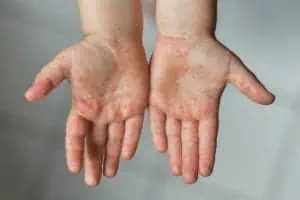 If you’re a parent, especially the parent of a child who’s ever been in daycare, you may be familiar with hand, foot and mouth disease, which causes fever, mouth sores and a rash. It most often affects children under the age of 5, but older kids — and yes, adults — can get it too.
If you’re a parent, especially the parent of a child who’s ever been in daycare, you may be familiar with hand, foot and mouth disease, which causes fever, mouth sores and a rash. It most often affects children under the age of 5, but older kids — and yes, adults — can get it too.
What is hand, foot and mouth disease?
Hand, foot and mouth disease (HFMD) is a highly contagious illness caused by a number of different viruses. In the United States, it’s most often caused by Coxsackievirus A16, one of a group of viruses known as enteroviruses. It’s usually not serious and resolves on its own in seven to 10 days. Symptoms appear in stages and may include:
- Lethargy
- Fever
- Decreased appetite
- Sore throat
- Small, painful sores in the mouth, often on the tongue or the roof of the mouth, that typically begin as flat red spots and may blister
- An itchy skin rash in the form of flat red spots, usually on the palms of the hands and/or soles of the feet, and sometimes on the knees, elbows, buttocks and/or genitals, that may blister
People can get HFMD at any time of the year, but it’s most common in summer and fall. There’s no specific treatment. Over-the-counter pain medicine can ease the pain and fever. (Don’t give aspirin to children or teens due to the risk of Reye’s syndrome.) A numbing mouthwash or spray can dull mouth pain, as can drinking cold liquids, which also provide hydration. Sucking on ice cubes or popsicles may also help. Avoid juice popsicles, which may be too acidic for comfort. Soft food may be preferable until the mouth sores begin to heal.
RELATED: Three Common Skin Rashes in Children
How does hand, foot and mouth disease spread?
The nose and throat secretions, saliva, blister fluid and feces of an infected person can all contain the virus. If your child is sick with HFMD, you can catch it by breathing in droplets from a cough or sneeze, changing a dirty diaper, kissing and hugging the child, sharing cups or utensils and touching blisters or contaminated surfaces, such as toys and pacifiers.
An infected person is most contagious the first week of the illness, but they can remain contagious for weeks after symptoms disappear. Children who develop HFMD should be kept home from school while they have symptoms and should avoid close contact with other kids for a few weeks afterward.
Symptoms of hand, foot and mouth disease in adults
Adults may experience the same HFMD symptoms as kids, though when adults develop symptoms they are usually milder (and may be misdiagnosed). Most of the time, however, adults have no symptoms, so they don’t know they’re contagious. If you do know or suspect you have HFMD, stay home from work.
A board-certified dermatologist can diagnose HFMD in both kids and adults. Note, if you had HFMD as a child, you’re probably immune.
Prevention measures
To avoid catching or spreading HFMD, practice good hygiene. Wash your hands with soap and water for at least 20 seconds:
- before eating
- after touching a contaminated surface, changing a diaper or using the toilet
- after blowing your nose
- before and after caring for someone who’s sick (including wiping a child’s nose)
Avoid touching your eyes, nose or mouth until you’ve washed up. Teach your kids to wash their hands, too.
It’s also smart to disinfect toys, doorknobs, faucet handles, pacifiers and other frequently touched surfaces. Limit close contact, to the extent possible, with a child who has the illness, and don’t share cups or utensils. If you or your child has HFMD, avoid close contact with pregnant women. The virus, especially if contracted near the end of pregnancy, can increase the chance of stillbirth or infect the infant.
Article Written By: Marianne Wait, an award-winning health and wellness writer based in New Jersey.
Medical Review By: Ted Schiff, MD





